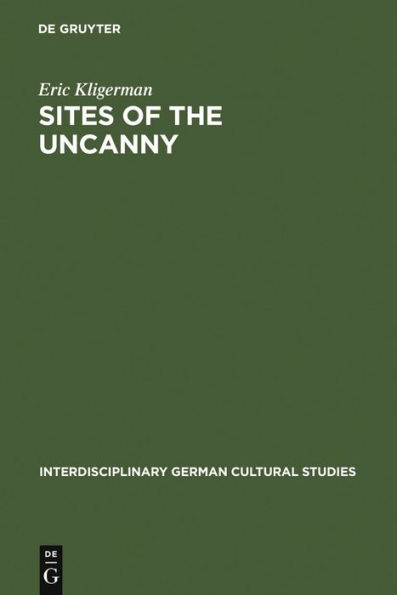5
1

Sites of the Uncanny: Paul Celan, Specularity and the Visual Arts
341
by Eric Kligerman
Eric Kligerman

Sites of the Uncanny: Paul Celan, Specularity and the Visual Arts
341
by Eric Kligerman
Eric Kligerman
Hardcover
$210.00
-
PICK UP IN STORECheck Availability at Nearby Stores
Available within 2 business hours
Related collections and offers
210.0
In Stock
Overview
Sites of the Uncanny: Paul Celan, Specularity and the Visual Arts is the first book-length study that examines Celan’s impact on visual culture. Exploring poetry’s relation to film, painting and architecture, this study tracks the transformation of Celan in postwar German culture and shows the extent to which his poetics accompany the country’s memory politics after the Holocaust. The book posits a new theoretical model of the Holocaustal uncanny – evolving out of a crossing between Celan, Freud, Heidegger and Levinas – that provides a map for entering other modes of Holocaust representations. After probing Celan’s critique of the uncanny in Heidegger, this study shifts to the translation of Celan’s uncanny poetics in Resnais’ film Night and Fog, Kiefer’s art and Libeskind’s architecture.

Product Details
| ISBN-13: | 9783110191356 |
|---|---|
| Publisher: | De Gruyter |
| Publication date: | 08/20/2007 |
| Series: | Interdisciplinary German Cultural Studies , #3 |
| Pages: | 341 |
| Product dimensions: | 6.20(w) x 9.40(h) x 1.00(d) |
| Age Range: | 18 Years |
About the Author
Eric Kligerman, University of Florida, Gainesville, Florida, USA.
Table of Contents
Acknowledgments ixList of Illustrations xi
Introduction: Facing the Holocaust 1
Positioning the Spectator 1
Empathic Imagination: Identification and the Other 6
"All Poets are Yids": Translating the Holocaust 10
Poetry as Flaschenpost 17
A New Category: the Holocaustal Uncanny 23
Specular Disruptions-The Sublime, the Uncanny, and Empathic Identification 31
Elements of Kant's Sublime: Subreption, Negative Presentation and Shudder 34
"To see a hundred corpses lie side by side, or five hundred or a thousand..." 37
Friedlander and the Historian's Unease 42
Haidu and the "strangely familiar" of Himmler's Posen Speech 46
Dominick LaCapra: Empathic Unsettlement and Compulsive Repetition 49
Crossing from the Sublime into Trauma: The Holocaustal Uncanny 55
The Uncanny Ethics of Levinas and Celan 62
Catastrophe and the Uncanny in Heidegger's Fetishized Narrative 74
A Missed Encounter: Heidegger and Celan 74
Heidegger and Narrative Fetishism 79
Fear and Anxiety in Heidegger's Being and Time 84
Antigone: The Uncanny, History, and Loss of the Ethical 88
Memorial Address 95
Broken Meridians-From Heidegger's Pathway to Celan's Judengasse 104
Bremen's Ghost 105
Freud's Uncanny: Doubles, Repetitions, Ghosts, Blindings and the Medusa's Head 113
Following the Path of Art: Poetry and the Uncanny 116
Translations: The Ethics of an Encounter 122
Departing From Heidegger's Feldweg 127
Mourning and Translation 132
Celan's Cinematic-Anxiety of the Gaze in Nuit et Brouillard and "Engfuhrung" 138
Resnais and the Visual Arts 146
Celan and the Visual Arts 151
Van Gogh's Cornfield with Crows: Crossing Film and Poetry 154
"Beide Welten": Inside the Camps 158
The Face and the Trace 164
Going into the Narrows: Celan's "Engfuhrung" 172
Re-figuring Celan in the Paintings of Anselm Kiefer 187
Textual Mourning for Celan In Bachmann's Malina 187
The Return of Paul Celan 195
Kiefer's Reception in Germany 199
Kiefer's Act of Decathexis: Lost Objects and Landscapes 202
Remembering Celan, Remembering the Holocaust 209
Coda: Lichtzwang 227
Ghostly Demarcations-Translating Paul Celan's Poetics in Daniel Libeskind's Architectural Space 233
Trauma and the Forming of Cultural Identity 233
Translating Anxiety into Architecture 239
Entering The Jewish Museum in Berlin 244
Inscribing the Void in Architecture 250
Void and Breathturn 255
Architectural Melancholia 268
Cartography and Ruins 275
Conclusion: Mnemosyne and the Ruins of History 290
Paul Celan in Tubingen 290
Martin Walser in Frankfurt 296
Bibliography 313
Index of Names 327
From the B&N Reads Blog
Page 1 of
